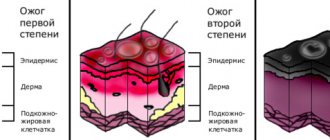The widespread use of electrical equipment in production and in a variety of electrical equipment in everyday life contributes to an increase in the level of electrical injuries, which is accompanied by electric shock. Electric current, under certain conditions, is a dangerous damaging factor that negatively affects the human body. In Fig. Below is a human hand injured by an electric shock.
Electrical injury to the hand
The effect of electric current on the human body
The mechanism of the negative impact of electric current on the human body is complex and diverse. As the current passes through the body, it has the following types of effects:
- Thermal effects, manifested by heating of the skin and tissue of internal organs, up to burns, leading to damage to blood vessels, nerve fibers and the brain and necrosis of tissue in parts of the body. When exposed to thermal effects, sharp functional disorders of human life support systems are observed, for example, sudden bleeding;
- Electrolytic effects, causing electrolysis of lymphatic fluid and decomposition of blood, disrupting the physico-chemical composition of all body tissues;
- Biological impact, expressed in disruption of the normal course of bioelectric processes inherent in living matter. The action of biocurrents that control the internal movements of the tissues of the human body is disrupted, which leads to involuntary unnatural convulsive contractions of the heart muscles and lungs. Living cells and tissues, with which the vitality of the organism is associated, become dangerously excited by the influence of current and may die;
- The mechanical action of an electric current, which causes separation and rupture of tissue due to the explosive formation of steam from blood and lymphatic fluid. The mechanical action provokes strong muscle contractions, up to the rupture of muscle fibers;
- Light effect, characterized by electroophthalmia after exposure to a powerful stream of ultraviolet radiation from an electric arc flash. External signs of electric shock include inflammation of the outer membrane of the eye.
In Fig. Below is an eye with signs of electroophthalmia.
Manifestations of electroophthalmia
Instructions for handling electrical appliances
In fact, the rules are not complicated, but we will only talk about those cases that can cause harm to a person at home. These rules should be told to children, but parents should never forget about them.
So, the following things cannot be done using electrical appliances:
- Do not touch electrical appliances with wet hands.
- If you see a bare wire, do not touch it under any circumstances.
- If you are repairing an electrical appliance, you should not plug it into an outlet, even if you are 100% sure that nothing will happen.
- Do not pull the wire to remove it from the outlet.
- Always make sure appliances are turned on when you leave home.
- Do not plug in powerful appliances.
- If there is smoke or odor, turn off the circuit breaker immediately.
Electrical injury concept
Premises according to the degree of danger of electric shock
The pathophysiological result of various effects of electric currents of varying strength on a person is electric shock, interpreted by GOST R IEC 61140-2000 “Protection against electric shock. General safety provisions..." as "...the physiological effect of electric current passing through the human body" (clause 3.1). The entire complex of changes in anatomical relationships in the body, dysfunctions of systems, organs and tissues, accompanied by a corresponding reaction of the body to the action of the current flowing through it, is usually called electrical trauma. In everyday speech, electrical trauma refers to electrical damage that is detected visually (burn) or by the body’s response of the following type:
- a feeling of a mechanical jolt or shock when an electric shock occurs;
- muscle cramps with painful effect;
- cardiac fibrillation, expressed in disruption of the functioning of the heart muscle, up to cardiac arrest and clinical death.
Note! The likelihood of a fatal electric shock falls into the category of implicit dangers, since there are no external attributes and signs of a real impending danger so that people could detect them in advance using their senses (for example, by analogy with a “hot-cold” or “dull-sharp” object).
The severity of electric shock, depending on the body's reaction, is divided as follows:
- First degree – muscle cramps, increased blood pressure, severe dizziness, but without loss of consciousness;
- The second degree is muscle cramps and loss of consciousness, which quickly returns, but the state of fear persists for a long time. Sometimes there is partial paralysis;
- The third degree is convulsions of muscle groups, leading to ruptures of soft tissues and dislocations of joints. Cardiac activity and breathing are impaired, and loss of consciousness occurs. Due to spasm of the vocal cords, the victim is unable to scream for help;
- Fourth degree – paralysis of the respiratory system, fibrillation of the heart muscle. Clinical death.
Important! Clinical death is the transition period that begins from the moment breathing and cardiac arrest stop. The victim of an electric shock has no signs of life, his heart is not working, and there is no breathing. However, in case of electric shock during the period of clinical death, the vital functions of the organs do not immediately fade away, which gives a chance to save a person’s life if appropriate assistance is provided in time - artificial respiration and cardiac massage.
What happens if a person gets an electric shock?
If a strong charge of electric current is passed through a person, there can be two outcomes:
- He will get a severe burn.
- Death. After all, too much energy can cause fibrillation. It occurs due to the fact that all the ventricles of the heart work “on their own wavelength,” and the charge can force them to stop or work for some time in the same rhythm.
A person can also simply lose consciousness, although such cases occur less frequently.
If we talk about the healing properties of electric current, then it is worth remembering hospital defibrillators, which are used when a person experiences heart failure. This device contracts the heart muscles so that they begin their work and return to their usual rhythm. However, defibrillators have a certain charge of energy that does not harm a person.
Classification of electrical injuries
Safety precautions when handling electric current
Electrical injuries are classified according to the following criteria:
- At the location of the electric shock injury;
In general, three types of traumatic injuries by currents of different origins are defined:
- Industrial electrical injuries - if a person was injured at work while working with equipment powered by electricity;
- Domestic injuries from electricity received in domestic conditions. Mostly, housewives and small children are susceptible to household electrical injuries. The main reasons are ignoring safety requirements when handling household appliances (washing machines, electric microwaves, irons);
- Natural electrical injuries – as a result of exposure to natural electricity. A classic example is a lightning strike, which is a discharge of atmospheric electricity.
In Fig. Below is a typical household electrical injury - a burn to the hand after an electric shock from a faulty electrical appliance.
Household electrical injury
- By the nature of the current (duration of exposure);
The temporary nature of the effect of current leads to two types of electrical injuries:
- Instant electrical injuries resulting from the action of an electric discharge for a short period of time (so-called electric shock). They have life-threatening injuries that require urgent medical attention;
- The chronic course of electrical injuries associated with the long-term and imperceptible influence of electric fields on a person. For example, personnel working near powerful high-voltage generators are susceptible to chronic electrical injuries. Symptoms of chronic damage are manifested in increased fatigue, tremors, high blood pressure, sleep disturbances, and memory impairment.
- Based on the nature of the lesion, the following were determined:
- Local electrical injuries, characterized by local (local) damage to a specific part of the body;
- General electrical injuries, which are extensive damage to the body as a result of electric current flowing through it. With general electrical injuries, cardiac and respiratory arrest may occur, leading to the clinical death of the injured person.
According to statistics, damage from electric shocks is distributed as follows:
- 20% of all cases are local electrical injuries;
- 25% – general injuries;
- 55% are mixed, in which local and general lesions of the body simultaneously appear.
What to do in case of electric shock?
If you witness someone electrocuted and still under the influence, you need to free them as quickly as possible. Since the outcome of an electrical injury directly depends on the duration of contact, the speed of response should be maximum.
Firstly, it is necessary to de-energize the electrical installation or its parts with which a person interacts. Automatic machines, switches or fuses located in the immediate vicinity are best suited for this. For high-voltage networks, their analogues are switches and disconnectors. If these are not available, other measures can be used to reduce the duration of exposure.
For lines up to 1 kV, any dry clothing wrapped around your hand can be suitable; ideally, these should be dielectric gloves. They can pull the victim by the loose ends of dry clothing. Use a tool with insulated handles to cut through the wire. You can also break the electrical circuit by placing a sheet of dielectric between the victim and the ground.
In devices above 1 kV, approaching the victim is dangerous because the rescuer himself may come under step voltage. But, in this case, you can throw any uninsulated wire between the source and the victim. Try to pull the wire away with an insulating rod, but wear dielectric gloves. The cable, also wearing gloves, can be cut in phases with an ax.
Types of local electrical injuries
Local electrical injuries (hereinafter referred to as ME) are pronounced local violations of the anatomical integrity of tissues, including bone, caused by the damaging effects of electric current and arc. In most cases, ME is cured, and the functions of the victim’s organs are partially or completely restored. Cases of death from ME are quite rare, most often death occurs from a severe burn. The danger of ME and the complexity of treatment are assessed according to the following factors:
- location, nature and extent of tissue/tissue damage;
- the body's response to local damage.
Types of electric shock
The most typical types of ME are:
- Electrical burns, which are the result of thermal aggression of electric current as it flows through the body;
- Electrical signs (marks), represented by compacted areas of pale yellow color in the form of sharply defined spots on the skin of an electric shock victim. May appear as a cut or puncture wound, or as a charred area on the body. In the area with the electrical mark, the skin loses sensitivity;
- Metallization of the skin, caused by the penetration into the upper layers of human skin of microparticles of metal melted during the burning of an electric arc, or charged metal particles from baths with electrolyte;
Additional Information. When a short circuit occurs or the switch is turned off under load, a powerful heat flow is generated, which initiates the melting of the metal of the current-carrying elements. The dynamic forces that arise during a short circuit spray particles of molten metal, which fly around at high speed.
- Mechanical damage as a result of uncontrolled sharp convulsive muscle contractions during electric shock. There are dislocations of joints and ruptures of ligaments, ruptures of nerve fibers and blood vessels;
- Electroophthalmia.
Let's take a closer look at electrical burns as the most common ME.
Electrical burns
Electrical burns account for almost 60% of all MEs. According to the conditions of origin, electrical burns are divided into two categories of injuries:
- current (or contact) burn injuries that occur during the flow of electric current directly through the human body when a person comes into direct contact with current-carrying elements;
- arc burns caused by damage from an electric arc.
In Fig. Below is an example of an arc flash captured by a CCTV camera.
Arc Flash
Electrical burns occur in electrical installations with low voltage, not exceeding 2 kV. Higher voltages usually produce a spark or arc that causes burns. According to the severity of the injury, electric burns are divided as follows:
- I degree - minor damage to the upper layers of the skin epidermis, redness and swelling of the skin without blistering. The injury can be easily healed at home and sometimes does not even require treatment;
- II degree - along with the usual damage to the upper layer of the skin, blisters filled with yellowish exudate appear (in everyday life, blisters from a burn are simply called blisters). For small burn areas, inpatient treatment at home is quite sufficient;
- III degree - the skin is affected throughout its entire thickness with the development of necrosis, which does not allow its independent regeneration (necrosis of the skin and subcutaneous tissue);
- IV degree – complete necrotic damage to the skin, tissue, muscles, bones and tendons. Visually, the consequences are expressed by charred limbs and other parts of the body.
Important! Surgery is required to treat third and fourth degree burns.
In Fig. The following illustrates the extent of electrical burn injuries.
Severity of electrical burns
There is no need for current to pass through a person for arc burns to occur. When an arc burns, a powerful flow of thermal energy is generated, which can cause severe burns up to degrees III and IV.
Injuries
Conditions under which injury may occur:
- Touching exposed parts of electrical appliances that are energized.
- Accidents that are caused by inconsistency in the work of personnel.
- Touching the housing of electrical devices that are out of order and on the surface of which there is voltage or leakage currents are retained.
- Accidentally approaching the affected area of faulty high-voltage power lines.
- Getting into the area of an electric arc.
- Touching electrical devices with a tool (made of conductive materials).
- Exposure to overvoltage.
- Touching pipes and metal structures that are energized (being hit by a broken wire, etc.).
- Malfunction of fencing devices of repair facilities. Lack of necessary measures to limit access to hazardous elements.
- Power supply without warning. Incorrect switching on of outgoing circuit breakers at substations.
- Lack of protective grounding.
- The occurrence of short circuits during repair work.
- Malfunction of electrical appliances. Violation of the integrity of insulating surfaces.
- Breakdowns in insulation caused by overheating and melting of the protective layer of cables.
- Using broken electrical appliances.
- Malfunctions on power lines.
- Short circuits.
- Operational errors: accidental contact with dangerous devices, falls, etc.
- Electric arc. Occurs when the maximum permissible safe distance between a person and an electrical installation is exceeded by more than 1 kV.
- The occurrence of step voltage in the presence of a bare live conductor.
- Lightning strikes in installations not equipped with lightning rods. An electric current of large magnitude arises. The incident is often accompanied by a fire.
- High humidity in a room with a faulty electrical installation: the presence of condensation on the walls and floors leads to damage to living organisms.
- Leaving electrical installations unattended when the circuit is closed. It is a common cause of injury.
- Faulty or missing grounding circuit. Memory malfunction.
- Breakdown of the SZ. Occurs due to inattention to the work process of staff.
- External factors: the occurrence of voltage on live parts due to repeated accidents - at supply substations, lightning strikes during work, etc.
General electrical injuries
General electrical injuries (hereinafter referred to as GE) are characterized by damage to two or more parts of the body or several internal organs at once. A direct threat to the life of the body is posed by disturbances in the normal functioning of various life support systems, including the functioning of the heart, brain and central nervous system.
The damaging potential of electric current depends on the following main factors:
- Type of current (alternating or direct) and frequency of current;
- Current strength and applied voltage;
- Current duration;
- Electric current paths;
It is customary to distinguish the following loops of the probable passage of current through the body (see figure below):
- pos. 1 – “hand-to-hand”;
- pos. 2 – “left arm and legs”;
- pos. 3 – “right arm-leg”;
- pos. 4 – “arms and legs”;
- pos. 5 – “leg-leg”;
- pos. 6 – “head-legs”;
- pos. 7 – “head-hand”;
- pos. 8 – “head-leg”.
Possible paths of current through the body
The most dangerous in terms of the degree of damage are considered to be the “head-arm” (pos. 7) and “head-leg” (pos. 8) loops, which are characterized by the passage of current through the brain and spinal cord. The least dangerous is the “leg-leg” loop (position 5), which practically does not affect vital organs.
- Resistance of the human body and the condition of the skin;
- Individual characteristics of the human body;
- Ambient air humidity.
Accidents associated with electric shock can be avoided if you strictly follow safety requirements when operating electrical equipment or do not use faulty household electrical appliances (for example, in everyday life they often neglect to carefully connect wires to sockets, using exposed wires, which can lead to electrical injury). Proper design, installation or repair of electrical devices ensures their safe operation.
In Fig. The following shows dangerous wiring connections to sockets.
Dangerous connection to sockets
Precautions to Protect Against Electric Shock
To avoid electric shock and minimize the causes that could cause it, it is enough to follow a number of simple rules:
- Do not touch electrical appliances, switches, plugs, sockets with wet hands;
- Do not allow faulty devices or devices that do not have chassis grounding to be connected to the network (the absence is allowed only for devices designed for very low voltage);
- Do not violate the instructions prescribed by electrical signs that regulate certain actions;
- Do not leave the appliances on when leaving home, and do not allow the plug to be pulled out by the cord;
- When working in electrical installations, be sure to comply with the requirements of the rules, instructions, and the procedure for technological processes;
- Work in electrical installations should only be carried out using the necessary protective equipment.








